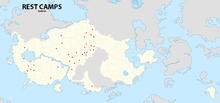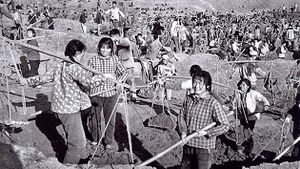REST
  | |
| Re-education Service Treatment | |
|---|---|
|
The REST, or Re-education Service Treatment, or REST Camps, was a collection of prison camps located in Jingdao during the Great Jing Dynasty. The camps were focused on re-educating their prisoners through forced labour and obligatory propaganda lessons. While not focused on any specific ethnic group, a majority of its prisoners were from Kildarian descent. Tegong officers refer to internees as People in Need of Enlightenment.
While in existence since the rise of the Great Jing, the REST camps saw a sharp increase in prisoners during the Post-Chidao Troubles, in the Tegong State. It became a major part of its war economy and its detainees were used in several large scale military projects. Simultaneously, camps which were not within the reach of the Tegong State kept functioning - at a smaller scale - in the eastern provinces.
Several settlements, mostly in Central Apollonia, were originally REST camps which over time developed in local transport hubs and small towns.
Prisoners
Political dissidents, mutineers, women who ignore their duties to birth children and increase the population,... are the main groups of people who end up in the camps. A high number of descendants of prisoners of war from the War of Lost Brothers were also put into REST, as they were deemed too dangerous to mingle with Jing society. These are heavily guarded and supervised by the Tegong.
Neither the Gunbatsu nor Kantai-ha held any authority over the re-education camps, but programs to aid in military works (naval development, etc.) have not been uncommon.
Success rate of re-education has been approximately around 76,66666666%.
Experiments
The first camps came into existence in 1625 AN to aid the government in pacifying the large Kildarian and Apollontean elite, but through time its focus moved towards supplying cheap labour or aid in social experiments.
After the War of Lost Brothers, whole REST cities were established in Outer Antya and Central Apollonia to house Florian prisoners of war. Social experiments to investigate if - for example - they were capable of governing a town with limited resources, were reported failures as their society digressed into organising football matches and building stadiums instead of giving priority to agricultural projects to grow the necessary crops to survive winter. Reports of Jing scientists with breakdowns were alarmingly higher among those in Florian camps than other camps.
Prisoners who were deemed impossible to re-educate are often lent to research facilities of Unit 666 for the betterment of humanity.